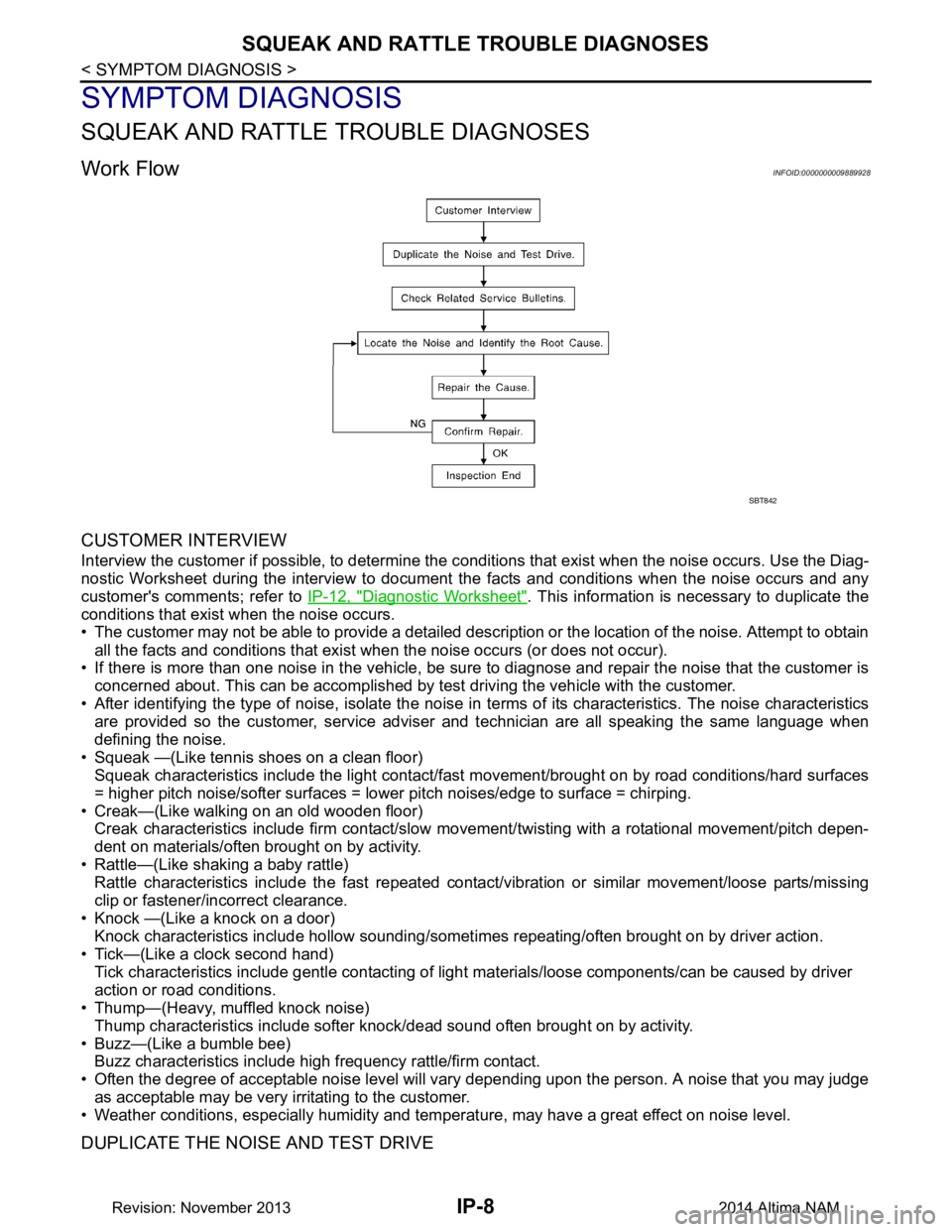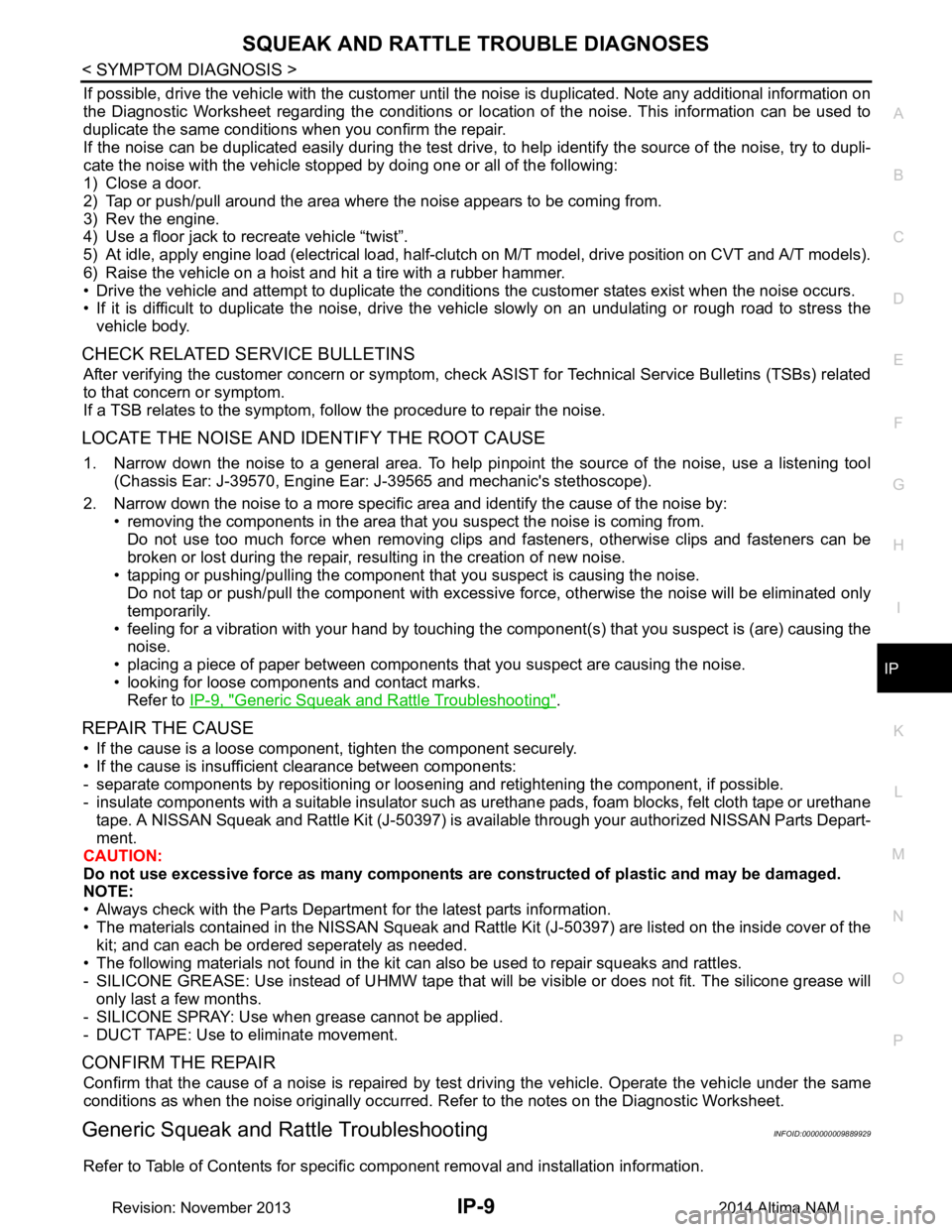2014 NISSAN TEANA SEC
[x] Cancel search: SECPage 2934 of 4801

IP-8
< SYMPTOM DIAGNOSIS >
SQUEAK AND RATTLE TROUBLE DIAGNOSES
SYMPTOM DIAGNOSIS
SQUEAK AND RATTLE TROUBLE DIAGNOSES
Work FlowINFOID:0000000009889928
CUSTOMER INTERVIEW
Interview the customer if possible, to determine the conditions that exist when the noise occurs. Use the Diag-
nostic Worksheet during the interview to document the facts and conditions when the noise occurs and any
customer's comments; refer to IP-12, "Diagnostic Worksheet"
. This information is necessary to duplicate the
conditions that exist when the noise occurs.
• The customer may not be able to provide a detailed description or the location of the noise. Attempt to obtain
all the facts and conditions that exist w hen the noise occurs (or does not occur).
• If there is more than one noise in the vehicle, be sure to diagnose and repair the noise that the customer is
concerned about. This can be accomplished by test driving the vehicle with the customer.
• After identifying the type of noise, isolate the noise in terms of its characteristics. The noise characteristics
are provided so the customer, service adviser and technician are all speaking the same language when
defining the noise.
• Squeak —(Like tennis shoes on a clean floor) Squeak characteristics include the light contact/fast movement/brought on by road conditions/hard surfaces
= higher pitch noise/softer surfaces = lower pitch noises/edge to surface = chirping.
• Creak—(Like walking on an old wooden floor) Creak characteristics include firm contact/slow mo vement/twisting with a rotational movement/pitch depen-
dent on materials/often brought on by activity.
• Rattle—(Like shaking a baby rattle) Rattle characteristics include the fast repeated contac t/vibration or similar movement/loose parts/missing
clip or fastener/incorrect clearance.
• Knock —(Like a knock on a door) Knock characteristics include hollow sounding/someti mes repeating/often brought on by driver action.
• Tick—(Like a clock second hand) Tick characteristics include gentle contacting of light materials/loose components/can be caused by driver
action or road conditions.
• Thump—(Heavy, muffled knock noise)
Thump characteristics include softer k nock/dead sound often brought on by activity.
• Buzz—(Like a bumble bee) Buzz characteristics include hi gh frequency rattle/firm contact.
• Often the degree of acceptable noise level will vary depending upon the person. A noise that you may judge
as acceptable may be very irritating to the customer.
• Weather conditions, especially humidity and temperat ure, may have a great effect on noise level.
DUPLICATE THE NOISE AND TEST DRIVE
SBT842
Revision: November 20132014 Altima NAM
Page 2935 of 4801

SQUEAK AND RATTLE TROUBLE DIAGNOSESIP-9
< SYMPTOM DIAGNOSIS >
C
D E
F
G H
I
K L
M A
B
IP
N
O P
If possible, drive the vehicle with the customer until the noise is duplicated. Note any additional information on
the Diagnostic Worksheet regarding the conditions or lo cation of the noise. This information can be used to
duplicate the same conditions when you confirm the repair.
If the noise can be duplicated easily during the test drive, to help identify the source of the noise, try to dupli-
cate the noise with the vehicle stopped by doing one or all of the following:
1) Close a door.
2) Tap or push/pull around the area where the noise appears to be coming from.
3) Rev the engine.
4) Use a floor jack to recreate vehicle “twist”.
5) At idle, apply engine load (electrical load, half-clutch on M/T model, drive position on CVT and A/T models).
6) Raise the vehicle on a hoist and hit a tire with a rubber hammer.
• Drive the vehicle and attempt to duplicate the conditions the customer states exist when the noise occurs.
• If it is difficult to duplicate the noise, drive the vehicle slowly on an undulating or rough road to stress the
vehicle body.
CHECK RELATED SERVICE BULLETINS
After verifying the customer concern or symptom, che ck ASIST for Technical Service Bulletins (TSBs) related
to that concern or symptom.
If a TSB relates to the symptom, follow the procedure to repair the noise.
LOCATE THE NOISE AND IDENTIFY THE ROOT CAUSE
1. Narrow down the noise to a general area. To help pi npoint the source of the noise, use a listening tool
(Chassis Ear: J-39570, Engine Ear: J-39565 and mechanic's stethoscope).
2. Narrow down the noise to a more specific area and identify the cause of the noise by: • removing the components in the area that you suspect the noise is coming from.Do not use too much force when removing clips and fasteners, otherwise clips and fasteners can be
broken or lost during the repair, resulting in the creation of new noise.
• tapping or pushing/pulling the component that you suspect is causing the noise.
Do not tap or push/pull the component with excessive force, otherwise the noise will be eliminated only
temporarily.
• feeling for a vibration with your hand by touching the component(s) that you suspect is (are) causing the
noise.
• placing a piece of paper between components that you suspect are causing the noise.
• looking for loose components and contact marks. Refer to IP-9, "Generic Squeak and Rattle Troubleshooting"
.
REPAIR THE CAUSE
• If the cause is a loose component, tighten the component securely.
• If the cause is insufficient clearance between components:
- separate components by repositioning or loos ening and retightening the component, if possible.
- insulate components with a suitable insulator such as urethane pads, foam blocks, felt cloth tape or urethane
tape. A NISSAN Squeak and Rattle Kit (J-50397) is av ailable through your authorized NISSAN Parts Depart-
ment.
CAUTION:
Do not use excessive force as many components are constructed of plastic and may be damaged.
NOTE:
• Always check with the Parts Department for the latest parts information.
• The materials contained in the NISSAN Squeak and Rattle Kit (J-50397) are listed on the inside cover of the
kit; and can each be ordered seperately as needed.
• The following materials not found in the kit can also be used to repair squeaks and rattles.
- SILICONE GREASE: Use instead of UHMW tape that will be visible or does not fit. The silicone grease will
only last a few months.
- SILICONE SPRAY: Use when grease cannot be applied.
- DUCT TAPE: Use to eliminate movement.
CONFIRM THE REPAIR
Confirm that the cause of a noise is repaired by test driving the vehicle. Operate the vehicle under the same
conditions as when the noise originally occurred. Refer to the notes on the Diagnostic Worksheet.
Generic Squeak and Rattle TroubleshootingINFOID:0000000009889929
Refer to Table of Contents for specific component removal and installation information.
Revision: November 20132014 Altima NAM
Page 2937 of 4801

SQUEAK AND RATTLE TROUBLE DIAGNOSESIP-11
< SYMPTOM DIAGNOSIS >
C
D E
F
G H
I
K L
M A
B
IP
N
O P
1. Loose harness or harness connectors.
2. Front console map/reading lamp lens loose.
3. Loose screws at console attachment points.
SEATS
When isolating seat noise it's important to note the pos ition the seat is in and the load placed on the seat when
the noise is present. These conditions should be duplic ated when verifying and isolating the cause of the
noise.
Cause of seat noise include:
1. Headrest rods and holder
2. A squeak between the seat pad cushion and frame
3. The rear seatback lock and bracket
These noises can be isolated by moving or pressing on the suspected components while duplicating the con-
ditions under which the noise occurs. Most of thes e incidents can be repaired by repositioning the component
or applying urethane tape to the contact area.
UNDERHOOD
Some interior noise may be caused by components under the hood or on the engine wall. The noise is then
transmitted into the passenger compartment.
Causes of transmitted underhood noise include:
1. Any component installed to the engine wall
2. Components that pass through the engine wall
3. Engine wall mounts and connectors
4. Loose radiator installation pins
5. Hood bumpers out of adjustment
6. Hood striker out of adjustment
These noises can be difficult to isolate since they cannot be reached from the interior of the vehicle. The best
method is to secure, move or insulate one component at a time and test drive the vehicle. Also, engine rpm or
load can be changed to isolate the noise. Repairs can usually be made by moving, adjusting, securing, or
insulating the component causing the noise.
Revision: November 20132014 Altima NAM
Page 2950 of 4801

LAN
LAN-1
ELECTRICAL & POWER CONTROL
C
D E
F
G H
I
J
K L
B
SECTION LAN
A
O P
N
CONTENTS
LAN SYSTEM
CAN FUNDAMENTAL
HOW TO USE THIS MANU AL ......................
7
HOW TO USE THIS SECTION ....................... .....7
Information .......................................................... ......7
PRECAUTION ...............................................8
PRECAUTIONS .............................................. .....8
Precautions for Trouble Diagnosis ...................... ......8
Precautions for Harness Repair ................................8
SYSTEM DESCRIPTION . .............................9
SYSTEM ......................................................... .....9
CAN COMMUNICATION SYSTEM .............................9
CAN COMMUNICATION SYSTEM : System De-
scription ............................................................... ......
9
DIAG ON CAN ....................................................... ......9
DIAG ON CAN : System Description ........................9
TROUBLE DIAGNOSIS .....................................11
Component Description ....................................... ....11
Condition of Error Detection ....................................11
Symptom When Error Occurs in CAN Communi-
cation System ...................................................... ....
12
CAN Diagnosis with CONSULT ..............................14
Self-Diagnosis .........................................................15
CAN Diagnostic Support Monitor ............................15
How to Use CAN Communication Signal Chart ......17
BASIC INSPECTION ...................................18
DIAGNOSIS AND REPAIR WORKFLOW ..... ....18
Trouble Diagnosis Flow Chart ............................. ....18
Trouble Diagnosis Procedure ..................................18
CAN
HOW TO USE THIS MANU AL .....................
23
HOW TO USE THIS SECTION .........................23
Information ........................................................... ....23
Abbreviation List ......................................................23
PRECAUTION ..............................................24
PRECAUTIONS .................................................24
Precaution for Supplemental Restraint System
(SRS) "AIR BAG" and "SEAT BELT PRE-TEN-
SIONER" ............................................................. ....
24
Precautions for Trouble Diagnosis ..........................24
Precautions for Harness Repair ..............................24
SYSTEM DESCRIPTION .............................26
COMPONENT PARTS ......................................26
Component Parts Location .................................. ....26
SYSTEM ............................................................27
CAN COMMUNICATION SYSTEM ........................ ....27
CAN COMMUNICATION SYSTEM : System De-
scription ............................................................... ....
27
CAN COMMUNICATION SYSTEM : CAN Com-
munication Control Circuit ................................... ....
30
CAN COMMUNICATION SYSTEM : CAN System
Specification Chart .............................................. ....
31
CAN COMMUNICATION SYSTEM : CAN Com-
munication Signal Chart ...................................... ....
32
WIRING DIAGRAM ......................................36
CAN SYSTEM .. ................................ .................36
Wiring Diagram .................................................... ....36
BASIC INSPECTION ...................................42
DIAGNOSIS AND REPAIR WORKFLOW ........42
Interview Sheet .................................................... ....42
DTC/CIRCUIT DIAGNOSIS .........................43
MALFUNCTION AREA CHART ........................43
Revision: November 20132014 Altima NAMRevision: November 20132014 Altima NAM
Page 2956 of 4801
![NISSAN TEANA 2014 Service Manual
LAN
HOW TO USE THIS SECTIONLAN-7
< HOW TO USE THIS MANUAL > [CAN FUNDAMENTAL]
C
D E
F
G H
I
J
K L
B
A
O P
N
HOW TO USE THIS MANUAL
HOW TO USE THIS SECTION
InformationINFOID:0000000009461390
• “ NISSAN TEANA 2014 Service Manual
LAN
HOW TO USE THIS SECTIONLAN-7
< HOW TO USE THIS MANUAL > [CAN FUNDAMENTAL]
C
D E
F
G H
I
J
K L
B
A
O P
N
HOW TO USE THIS MANUAL
HOW TO USE THIS SECTION
InformationINFOID:0000000009461390
• “](/manual-img/5/57390/w960_57390-2955.png)
LAN
HOW TO USE THIS SECTIONLAN-7
< HOW TO USE THIS MANUAL > [CAN FUNDAMENTAL]
C
D E
F
G H
I
J
K L
B
A
O P
N
HOW TO USE THIS MANUAL
HOW TO USE THIS SECTION
InformationINFOID:0000000009461390
• “CAN FUNDAMENTAL” of LAN Section describes t
he basic knowledge of the CAN communication system
and the method of trouble diagnosis.
• For information peculiar to a vehicle and inspection procedure, refer to “CAN”.
Revision: November 20132014 Altima NAMRevision: November 20132014 Altima NAM
Page 2960 of 4801
![NISSAN TEANA 2014 Service Manual
LAN
TROUBLE DIAGNOSISLAN-11
< SYSTEM DESCRIPTION > [CAN FUNDAMENTAL]
C
D E
F
G H
I
J
K L
B
A
O P
N
TROUBLE DIAGNOSIS
Component DescriptionINFOID:0000000009461395
Condition of Error DetectionINFOID: NISSAN TEANA 2014 Service Manual
LAN
TROUBLE DIAGNOSISLAN-11
< SYSTEM DESCRIPTION > [CAN FUNDAMENTAL]
C
D E
F
G H
I
J
K L
B
A
O P
N
TROUBLE DIAGNOSIS
Component DescriptionINFOID:0000000009461395
Condition of Error DetectionINFOID:](/manual-img/5/57390/w960_57390-2959.png)
LAN
TROUBLE DIAGNOSISLAN-11
< SYSTEM DESCRIPTION > [CAN FUNDAMENTAL]
C
D E
F
G H
I
J
K L
B
A
O P
N
TROUBLE DIAGNOSIS
Component DescriptionINFOID:0000000009461395
Condition of Error DetectionINFOID:0000000009461396
DTC (e.g. U1000 and U1001) of CAN communication is
indicated on SELF-DIAG RESULTS on CONSULT if a
CAN communication signal is not transmitted or received between units for 2 seconds or more.
CAN COMMUNICATION SYSTEM ERROR
• CAN communication line open (CAN-H, CAN-L, or both)
• CAN communication line short (ground, betw een CAN communication lines, other harnesses)
• Error of CAN communication control circuit of the unit connected to CAN communication line
WHEN DTC OF CAN COMMUNICATION IS I NDICATED EVEN THOUGH CAN COMMUNICATION
SYSTEM IS NORMAL
• Removal/installation of parts: Error may be detec ted when removing and installing CAN communication unit
and related parts while turning the ignition switch ON. (A DTC except for CAN communication may be
detected.)
• Fuse blown out (removed): CAN communication of the unit may cease.
• Voltage drop: Error may be detected if voltage drops due to discharged battery when turning the ignition switch ON (Depending on the control unit which carries out CAN communication).
• Error may be detected if the power supply circuit of the control unit, which carries out CAN communication,
malfunctions (Depending on the control unit which carries out CAN communication).
• Error may be detected if reprogramming is not completed normally.
NOTE:
CAN communication system is normal if DTC of CAN communication is indicated on SELF-DIAG RESULTS of
CONSULT under the above conditions. Erase the memory of the self-diagnosis of each control unit.
JSMIA0527GB
Component Description
Main line CAN communication line between splices
Branch line CAN communication line between splice and a control unit
Splice A point connecting a branch line with a main line
Termination circuit Circuit connected across the CAN communication system. (Resistor)
Revision: November 20132014 Altima NAMRevision: November 20132014 Altima NAM
Page 2964 of 4801
![NISSAN TEANA 2014 Service Manual
LAN
TROUBLE DIAGNOSISLAN-15
< SYSTEM DESCRIPTION > [CAN FUNDAMENTAL]
C
D E
F
G H
I
J
K L
B
A
O P
N
• Response to the system call
• Control unit diagnosis information
• Self-diagnosis
• C NISSAN TEANA 2014 Service Manual
LAN
TROUBLE DIAGNOSISLAN-15
< SYSTEM DESCRIPTION > [CAN FUNDAMENTAL]
C
D E
F
G H
I
J
K L
B
A
O P
N
• Response to the system call
• Control unit diagnosis information
• Self-diagnosis
• C](/manual-img/5/57390/w960_57390-2963.png)
LAN
TROUBLE DIAGNOSISLAN-15
< SYSTEM DESCRIPTION > [CAN FUNDAMENTAL]
C
D E
F
G H
I
J
K L
B
A
O P
N
• Response to the system call
• Control unit diagnosis information
• Self-diagnosis
• CAN diagnostic support monitor
Self-DiagnosisINFOID:0000000009461399
If communication signals cannot be transmitted or rece ived among control units communicating via CAN com-
munication line, CAN communication-related DTC is displayed on the CONSULT “Self Diagnostic Result”
screen.
NOTE:
The following table shows examples of CAN communicati on-related DTC. For other DTC, refer to the applica-
ble sections.
CAN Diagnostic Support MonitorINFOID:0000000009461400
MONITOR ITEM (CONSULT)
Example: CAN DIAG SUPPORT MNTR indication
Without PAST
DTC Self-diagnosis item
(CONSULT indication) DTC detection condition Inspection/Action
U1000 CAN COMM CIRCUIT ECM
When ECM is not transmitting or receiving CAN
communication signal of OBD (emission-relat-
ed diagnosis) for 2 seconds or more.
Start the inspection. Re-
fer to the applicable sec-
tion of the indicated
control unit.
Except
for ECM When a control unit (except for ECM) is not
transmitting or receiving CAN communication
signal for 2 seconds or more.
U1001 CAN COMM CIRCUIT When ECM is not transmitting or receiving CAN communi-
cation signal other than OBD (emission-related diagnosis)
for 2 seconds or more.
U1002 SYSTEM COMM When a control unit is not transmitting or receiving CAN
communication signal for 2 seconds or less.
U1010 CONTROL UNIT(CAN) When an error is detected during the initial diagnosis for
CAN controller of each control unit. Replace the control unit
indicating “U1010”.
JSMIA0964GB
Item PRESENT Description
Initial diagnosis OK Normal at present
NG Control unit e rror (Except for some control units)
Revision: November 20132014 Altima NAMRevision: November 20132014 Altima NAM
Page 2965 of 4801
![NISSAN TEANA 2014 Service Manual
LAN-16
< SYSTEM DESCRIPTION >[CAN FUNDAMENTAL]
TROUBLE DIAGNOSIS
With PAST
Transmission diagnosisOK Normal at present
UNKWN Unable to transmit signals for 2 seconds or more.
Diagnosis not performed
NISSAN TEANA 2014 Service Manual
LAN-16
< SYSTEM DESCRIPTION >[CAN FUNDAMENTAL]
TROUBLE DIAGNOSIS
With PAST
Transmission diagnosisOK Normal at present
UNKWN Unable to transmit signals for 2 seconds or more.
Diagnosis not performed](/manual-img/5/57390/w960_57390-2964.png)
LAN-16
< SYSTEM DESCRIPTION >[CAN FUNDAMENTAL]
TROUBLE DIAGNOSIS
With PAST
Transmission diagnosisOK Normal at present
UNKWN Unable to transmit signals for 2 seconds or more.
Diagnosis not performed
Control unit name
(Reception diagnosis) OK Normal at present
UNKWN Unable to receive signals for 2 seconds or more.
Diagnosis not performed
No control unit for receiving signals. (No applicable optional parts)
Item PRESENT Description
Item PRESENT PAST Description
Transmission diagnosis OKOK Normal at present and in the past
1 – 39 Normal at present, but unable to transmit signals for 2 seconds or more
in the past. (The number indicates the number of ignition switch cycles
from OFF to ON.)
UNKWN 0 Unable to transmit signals for 2 seconds or more at present.
Control unit name
(Reception diagnosis) OK
OK Normal at present and in the past
1 – 39 Normal at present, but unable to receive signals for 2 seconds or more
in the past. (The number indicates the number of ignition switch cycles
from OFF to ON.)
UNKWN 0 Unable to receive signals for 2 seconds or more at present.
Not diagnosed – Diagnosis not performed.
No control unit for receiving signals. (No applicable optional parts)
Revision: November 20132014 Altima NAMRevision: November 20132014 Altima NAM